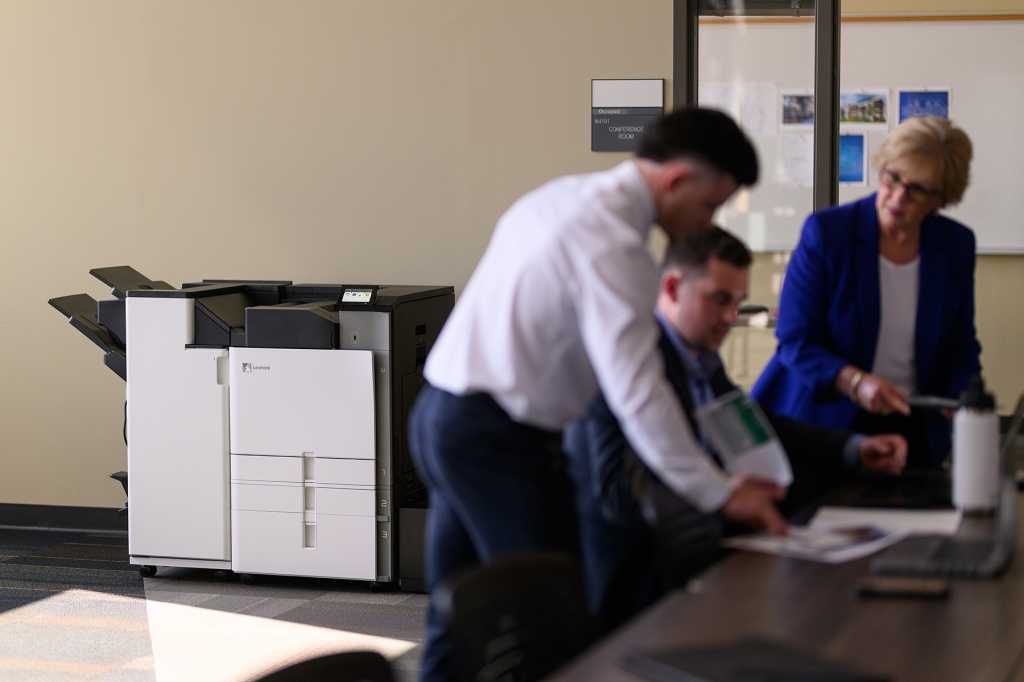The modern workplace thrives on sleek tablets, cloud storage and ways to go paperless. Yet, amid this digital hum, a familiar presence persists – the office printer. While a few predicted its obsolescence, the printing industry has defied expectations – proving that even in a digital world, there is an essential need for the printed word.
“The US print hardware market experienced a year-over-year shipment growth of 1% in Q1 2023, indicating a slight rebound after recent declines,” reads a July 2024 report from IDC, a global tech research firm.
This resurgence signals an undeniable truth: Printers aren’t going away; they’re evolving.
Businesses of all sizes are recognizing the future isn’t about going entirely paperless but striking a balance between physical and digital. In 2024 and beyond, there is growing demand for printers that seamlessly integrate into hybrid work environments, offer intuitive functionality, robust security and sustainable practices, while matching and even enhancing the digital tools we rely on daily. The printers of tomorrow don’t just put toner on paper – they bridge the gap between physical and digital workflows.
Before you click “print” on that next purchase order, business report or loan document, consider these three essential features that every office printer should have:
1. Effortless usability: Freeing up time for other tasks
In a world of intuitive apps and user-friendly software, a printer shouldn’t require an instruction manual to operate. The modern office demands a printer that’s as easy to use as other consumer technology.
Here’s how to get more from less:
- Intuitive interface: Touchscreens should be responsive and straightforward, providing a similar experience as a smartphone or tablet. Look for clearly labeled icons, logical menus and a design that prioritizes simplicity over unnecessary complexity.
- Simplified maintenance: An intentionally engineered design that is built to last delivers improved reliability and uptime, with minimal and easy maintenance. Seek devices with clear instructions and user-friendly prompts to speed up your printer operations, boost efficiency and reduce IT helpdesk calls.
“When we designed our new Lexmark 9-Series printers, we put user-friendliness and modern design at the forefront, building them with an intuitive user interface,” said Hayley Grant, a usability engineer at Lexmark. “We wanted printing, copying, scanning, faxing and more to be a breeze for users of all technical abilities, not just us printer geeks.”
Grant added that the 9-Series is built for simplified maintenance procedures, noting that “an experienced technician can perform the top 10 service actions in under 15 minutes,” according to Lexmark testing. “That’s less time than clearing your inbox,” she said.
2. Ironclad security: Protecting your data in a world of evolving threats
In an era of increasingly sophisticated cyberattacks, print vulnerabilities are often overlooked. A networked printer, if not properly secured, can be an entry point for hackers seeking to access sensitive data or disrupt operations. According to a survey by global technology analyst firm, Quocirca, 67% of respondents reported at least one print-related data breach in the past year.
Look to prioritize:
- Data encryption: Ensure your printer offers robust data encryption both in transit (while data is being sent to the printer) and at rest (while data is stored on the printer’s hard drive). This prevents unauthorized access to confidential documents, financial records and other sensitive information.
- User authentication: Implement strong user authentication measures to control who has printer access. This could include Active Directory, Secure LDAP, Kerberos, PIN codes, passwords or even contactless card solutions for an extra layer of security. By restricting access, you prevent unauthorized printing and safeguard confidential information.
“Lexmark puts security front of mind, equipping our printers, including the new 9-Series, with the industry’s most comprehensive security portfolio, right out of the box,” said Lexmark Chief Information Security Officer Bryan Willett. “Plus, with Lexmark’s remote management capabilities, you can rest easy knowing only authorized personnel can configure the device for network access.”
3. Sustainability for the future: Minimizing environmental footprint
As concern for the environment gains greater importance in the business world, it’s essential to choose technology that aligns with these values, leading to major cost savings since reliable equipment doesn’t need to be replaced as frequently. Top printers offer unparalleled reliability with an expected lifespan of seven or more years, which is significantly more than the industry standard.
Here’s what to consider:
- Energy efficiency: Streamline your print ecosystem and reduce your overall footprint by deploying multifunction devices that are fully featured and designed to save space. Choose models with efficient power supplies and certifications like ENERGY STAR®, a stringent energy efficiency standard authorized by the U.S. Environmental Protection Agency.
- Recycled materials: Support manufacturers that prioritize sustainability by choosing printers manufactured using post-consumer recycled (PCR) plastics. This reduces the demand for virgin materials and minimizes the environmental impact of manufacturing.
Look for a printer that puts sustainability at the forefront, incorporating recycled materials designed for energy efficiency and long lifespans. The Lexmark 9-Series’ total PCR content leads the industry: 56% by weight for all base-model MFPs and 73% by weight for the line’s base-model printer, based on IEEE calculation procedures.
Making the smart choice
By prioritizing usability, security and sustainability, you can choose a printer that seamlessly integrates into your modern office environment. Don’t settle for paper jams and outdated technology. Invest in a printer that empowers your team to work smarter, safer – together.
To explore how Lexmark printers are designed for the modern office, like the new 9-Series, click here.

